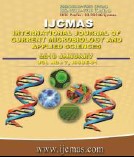


 National Academy of Agricultural Sciences (NAAS)
National Academy of Agricultural Sciences (NAAS)

|
PRINT ISSN : 2319-7692
Online ISSN : 2319-7706 Issues : 12 per year Publisher : Excellent Publishers Email : editorijcmas@gmail.com / submit@ijcmas.com Editor-in-chief: Dr.M.Prakash Index Copernicus ICV 2018: 95.39 NAAS RATING 2020: 5.38 |
The present investigation was conducted to assess the wilt/root rot incidence in chilli (Capsicum annum) in Kashmir and to examine management practices. Survey was carried out in three districts of Kashmir viz., Ganderbal, Baramullah and Pulwama during 2016. Damping-off and wilt/root rot incidence in the districts varied from 7-34 and 11-52% respectively with maximum in disease incidence in district in Ganderbal and minimum in Pulwama. The pathogens responsible for wilt/root rot are Fusarium pallidoroseum, F. oxysporum, F. solani, Phytophthora capsici, R. solani and Sclerotium rolfsii and Pythium sp. was observed to be incitant of damping-off. Wilt/root rot and damping-off being soil borne, the primary infections are needed to be controlled with suitable fungicides. Field experiments were conducted to study the disease control with different fungicides alone or in combination with bioagents. The results indicated that minimum wilt/root rot incidence (7.0%) and maximum dry fruit yield 74.73 q/ha was recorded in treatment combination of carbendazim (seed treatment) + metalaxyl (seedling dip) + hexaconazole (foliar spray) as compared to other possible combinations and their individual treatments. Wilt/root rot and dry fruit yield of chilli was investigated in response to various levels of organic amendments (FYM 20, 30 and 40 t/ha and vermicompost 10, 15 and 20 t/ha) alone and in combination with the recommended nitrogen fertilizer dose (RFD). Also, the impact of split doses of fertilizer application 60:60, 60:30:30, 40:40:40 and 80:40 on wilt/root rot complex was assessed. Vermicompost 20 q/ha + RFD was most effective in reducing the wilt/root rot incidence up to (21.0%) and increased dry fruit yield of chilli (55.10 q/ha) when compared to control.
 |
 |
 |
 |
 |